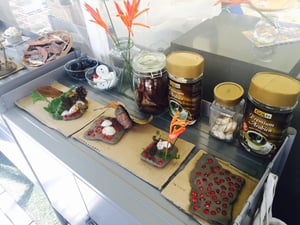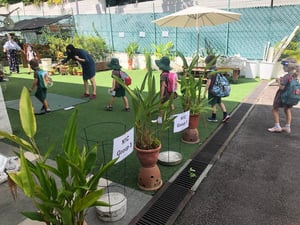The Reggio Emilia approach and why it benefits your child
Reggio Emilia is a town in Northern Italy and this world-renowned pedagogy was born after World War II founded by pedagogist Loris Malaguzzi. Supported by the entire community in Reggio Emilia, this approach is based on constructivist principles and stems from respect, responsibility, and community where learning happens through exploration, discovery, and play. Inspired by this pedagogy for the last 2 decades. EtonHouse also collaborated with Reggio Children to start REACH, Reggio Emilia in Asia for Children, which is a part of the Reggio Children international network.
You can listen to the podcast here.
What are the main principles that inform and guide this approach?
- The most common principle that defines the Reggio Emilia approach is that children have many languages. Loris Malaguzzi spoke about the hundred languages of children and this is where we believe that children have infinite ways to express themselves, explore and connect these thoughts to their imaginations and build connections to the world around them. In Reggio Emilia inspired preschools, the environment is mostly set up with resources and materials for children to connect to the hundred languages. They are active participants in their own learning and are able to use these materials to translate their way of thinking about the world around them. EtonHouse follows an interest-based approach where we honour children’s thinking and the community they are immersed in.
- Another principle contributing to the Reggio Emilia approach is having the environment as a child’s teacher. With the provocations specially prepared by the teachers, it plays a significant role in their learning as it inspires them to think and inquire. This also allows them to use the environment to further challenge their thinking.
- We acknowledge that children have the right to be heard. This pedagogical belief draws a connection to the EtonHouse Image of Child and Image of Educator. This powerful concept, therefore, creates a shared culture and energy within our school environment and the EtonHouse community. It defines our interactions with children, not just as educators but as parents as well.
Is Reggio Emilia a curriculum? How is it different from other approaches and curricula?
Reggio Emilia is an educational philosophy; it is an approach to education where we believe children are exploring life in itself. As this quote by John Dewey suggests, ‘Education is not preparation for life; education is life itself.’ Hence it is very much about children being able to explore real-life concepts within a setting and make real connections to the world around them, building life skills that extend as they transition through life. It is very different for Reggio Emilia educators as it doesn’t just mean putting on a teacher hat for the day and taking it off when school ends. Rather, it is an innate way of living that is unique in each of us because every one of us is very passionate about this approach that even when we interact with others in our personal lives, it is very similar to the way we interact in our professional lives.
education is life itself.’ Hence it is very much about children being able to explore real-life concepts within a setting and make real connections to the world around them, building life skills that extend as they transition through life. It is very different for Reggio Emilia educators as it doesn’t just mean putting on a teacher hat for the day and taking it off when school ends. Rather, it is an innate way of living that is unique in each of us because every one of us is very passionate about this approach that even when we interact with others in our personal lives, it is very similar to the way we interact in our professional lives.
With the environment as a child’s third teacher, what does a Reggio Emilia setting look like in your school?
Our classrooms include real elements and real materials that children have a natural connection to. In the home corner of our pre-nursery classes, we have actual items instead of plastic representations of them. This allows children to experience them naturally as they are already familiar with these items having seen them at home or in a restaurant. You will also be able to find complex items like wires, wire cutters and scissors where children are supported to understand the purpose of these tools and work with them in a safe manner, building on their life skills. 
You will find ateliers in our school, which are filled with creative materials that children are able to use to express their thinking and explore bigger concepts. Taking painting as an example, in other curriculums, these concepts are seen as play whereas our teachers will use this opportunity to observe children while they are engaged in this painting experience and notice if a child is exploring a big idea, transformation or movement. It stems from respecting young children as individuals who have their own thoughts and competencies. The Reggio Emilia approach can be adapted in all contexts and is universal.
How is a child’s progress assessed and documented in this approach?
Documenting children's voices is extremely important to us. Every year, EtonHouse launches documentation of inquiry that is explored across all age groups and year levels. This documentation helps us understand the learning processes of children more in-depth by observing them throughout the day. The teaching team comes together at the end of the day with the curriculum coordinator or principal for a sharing session of what was observed from each child in a collaborative and individual way.
How does this approach benefit my child and family? What are some of the long term implications?
When children and adults are exposed to Reggio inspired preschools and these real-life skills, they transition through life better and are set up for success. It sets them up to be able to use their knowledge and resources to feel confident, be able to ask questions, understand and be resilient.

Life has its challenges and we need to support children in understanding that. Now, as we are going through the COVID19 pandemic together, we put a lot of social distancing measures and hygiene protocols into place. Despite the changes, our children are able to adapt quickly as they have been exposed to the Reggio Emilia way of thinking and learning. They have demonstrated resilience in taking these new routines on. This itself reflects the benefits behind this educational approach in developing holistically lifelong learners who are excited for life.
Comments
Post a Comment